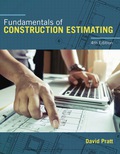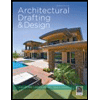
Fundamentals of Construction Estimating
4th Edition
ISBN: 9781337670999
Author: David Pratt
Publisher: Cengage Learning US
expand_more
expand_more
format_list_bulleted
Concept explainers
Textbook Question
Chapter 3, Problem 11RQ
What is an assembly, and how is the notion of assemblies used in the takeoff process?
Expert Solution & Answer
Want to see the full answer?
Check out a sample textbook solution
Students have asked these similar questions
Develop a signal design and timing for the intersection shown in the figure below. In each case
accommodate both vehicular and pedestrian movements. In general, use the following values
for the problem: pedestrian walking speed = 1 [m/s], vehicle deceleration = 3 [m/s²], driver
reaction time = 1.5 [s], length of vehicle 6 [m], and level grade = 0. If you need to assume
=
other variables and parameters to solve this problem clearly state that in your report and
explain the reason.
250
1100
One-way
Speed limit = 50 [km/h]
Pedestrian = 15 per each crosswalk
Crosswalk widths = 3 [m]
Lane width = 4 [m]
Saturation flow = 1800 [veh/h/lane]
1100
70
80
T 200
900
A pre-timed four-phase signal has critical lane group flow rates for the first three phases of
260, 280, and 310 [veh/h] (saturation flow rates are 2000 [veh/h/In] for all phases). The lost
time is known to be 5 seconds for each phase. If the cycle length is 90 seconds, what is the
estimated effective green time of the fourth phase?
a. Assume a bus line with N stops, where the distance between stops is S. Free flow speed of
the bus is v, with acceleration and deceleration, a. P passengers per stop are boarding and
alighting, and the time needed for a passenger to board or alight is T seconds. What is the
average speed of a bus?
b. Following on part (a), assume the origins of passengers are spread uniformly along the bus
route. The destination of all passengers is the last stop. The walking speed of passengers is
u. Determine the average travel time (walking + in-vehicle) of passengers.
c. Simplify the above equation when N is large enough (approximating N-1/2 by N-1).
Consider now that you can decide on S, where you replace N=L/S (L is the length of the
route). Find the value of S that minimises the travelling time of the passengers.
d. In the same setting as (c), assume that some passengers do not go to the terminal but alight
before. Explain if your answer from (c) would increase or decrease and why.
If you need…
Chapter 3 Solutions
Fundamentals of Construction Estimating
Ch. 3 - What is the objective of a quantity takeoff?Ch. 3 - Why is it recommended that estimators follow a...Ch. 3 - What is the difference between an estimator’s...Ch. 3 - Prob. 4RQCh. 3 - What are the two components that make up a takeoff...Ch. 3 - In what order are dimensions entered onto the...Ch. 3 - Why should a figured dimension be used in...Ch. 3 - Why should an estimator include headings and side...Ch. 3 - The cost of transportation of materials has to be...Ch. 3 - What level of accuracy should the estimator pursue...
Knowledge Booster
Learn more about
Need a deep-dive on the concept behind this application? Look no further. Learn more about this topic, civil-engineering and related others by exploring similar questions and additional content below.Similar questions
- The minimum cycle length for an intersection is determined to be 95 seconds. The critical lane group flow ratios were calculated as 0.235, 0.25, 0.17, and 0.125, respectively. Assuming 5 seconds lost per phase, determine which X was used.arrow_forwardA four-phase traffic signal has critical lane group flow ratios of 0.250, 0.150, 0.225 and 0.125. If the lost time per phase is 4 seconds and a critical intersection v/c of 0.85 is desired, calculate the minimum cycle length and the phase effective green times such that the lane group v/c ratios are equalized.arrow_forwardA pre-timed four-phase signal has critical lane group flow rates for the first three phases of 260, 280, and 310 [veh/h] (saturation flow rates are 2000 [veh/h/ln] for all phases). The lost time is known to be 5 seconds for each phase. If the cycle length is 90 seconds, what is the estimated effective green time of the fourth phase?arrow_forward
- PLEASE SOLVE THE QUESTIONS IN THE PICTURE, make sure you show all of your work please. Thank you for your help!arrow_forwardPlease solve the following question in the picture, make sure you show all of your work and formulas you use. Thank you so much for your help!arrow_forwardDetermine all the quantities mentioned. Show complete solution using Mohr's Circle only.arrow_forward
- B: Find the area of the region in the first quadrant that is within the cardioid r=1-cos 0 1-cos e TT/2 0arrow_forwardPlease do not use any AI tools to solve this question. I need a fully manual, step-by-step solution with clear explanations, as if it were done by a human tutor. No AI-generated responses, please.arrow_forwardPseudomonas putida is being used to biodegrade toluene in an in-situ, aerobic bioremediation system. The environmental conditions are oligotrophic, in that Pseudomonas is starved for other nutrients and organic carbon/energy sources, including toluene, which is present at low concentrations (S0 = 5 mg/L). It is able to perform oxidative phosphorylation using toluene as an electron donor to obtain ATP as a primary energy source that primarily fuels its biosynthesis pathways (i.e., fs ~ 1). During this oxidation process, toluene is degraded to a less harmful metabolite, benzoic acid. a) Given this information write out the kinetic model to describe the substrate degradation profile as a function of time. b) With the information in the Table below, compute the substrate (S) and biomass concentrations (X) after 3.5 days have elapsed. Assume that the initial degrading population is quite low, given the oligotrophic conditions (X0 = 0.5 mg/L). Biokinetic Model Parameter μmax Ks Y Kd Value…arrow_forward
arrow_back_ios
SEE MORE QUESTIONS
arrow_forward_ios
Recommended textbooks for you
 Fundamentals Of Construction EstimatingCivil EngineeringISBN:9781337399395Author:Pratt, David J.Publisher:Cengage,
Fundamentals Of Construction EstimatingCivil EngineeringISBN:9781337399395Author:Pratt, David J.Publisher:Cengage, Engineering Fundamentals: An Introduction to Engi...Civil EngineeringISBN:9781305084766Author:Saeed MoaveniPublisher:Cengage Learning
Engineering Fundamentals: An Introduction to Engi...Civil EngineeringISBN:9781305084766Author:Saeed MoaveniPublisher:Cengage Learning Construction Materials, Methods and Techniques (M...Civil EngineeringISBN:9781305086272Author:William P. Spence, Eva KultermannPublisher:Cengage Learning
Construction Materials, Methods and Techniques (M...Civil EngineeringISBN:9781305086272Author:William P. Spence, Eva KultermannPublisher:Cengage Learning Architectural Drafting and Design (MindTap Course...Civil EngineeringISBN:9781285165738Author:Alan Jefferis, David A. Madsen, David P. MadsenPublisher:Cengage Learning
Architectural Drafting and Design (MindTap Course...Civil EngineeringISBN:9781285165738Author:Alan Jefferis, David A. Madsen, David P. MadsenPublisher:Cengage Learning Materials Science And Engineering PropertiesCivil EngineeringISBN:9781111988609Author:Charles GilmorePublisher:Cengage Learning
Materials Science And Engineering PropertiesCivil EngineeringISBN:9781111988609Author:Charles GilmorePublisher:Cengage Learning Solid Waste EngineeringCivil EngineeringISBN:9781305635203Author:Worrell, William A.Publisher:Cengage Learning,
Solid Waste EngineeringCivil EngineeringISBN:9781305635203Author:Worrell, William A.Publisher:Cengage Learning,

Fundamentals Of Construction Estimating
Civil Engineering
ISBN:9781337399395
Author:Pratt, David J.
Publisher:Cengage,

Engineering Fundamentals: An Introduction to Engi...
Civil Engineering
ISBN:9781305084766
Author:Saeed Moaveni
Publisher:Cengage Learning

Construction Materials, Methods and Techniques (M...
Civil Engineering
ISBN:9781305086272
Author:William P. Spence, Eva Kultermann
Publisher:Cengage Learning

Architectural Drafting and Design (MindTap Course...
Civil Engineering
ISBN:9781285165738
Author:Alan Jefferis, David A. Madsen, David P. Madsen
Publisher:Cengage Learning

Materials Science And Engineering Properties
Civil Engineering
ISBN:9781111988609
Author:Charles Gilmore
Publisher:Cengage Learning

Solid Waste Engineering
Civil Engineering
ISBN:9781305635203
Author:Worrell, William A.
Publisher:Cengage Learning,
What Is A Construction Takeoff? | Are They Still Necessary In Quantity Surveying?; Author: Metroun Quantity Surveying;https://www.youtube.com/watch?v=uTWoDPtcOjg;License: Standard Youtube License